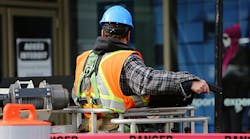Full-time safety professionals with at least one certification earn $20,000 more per year than those with none, according to a new survey from the Board of Certified Safety Professionals (BCSP) and the American Society of Safety Engineers (ASSE).
The 33-question salary questionnaire surveyed nearly 10,000 safety, health and environmental professionals based primarily in the United States and Canada. It identified the typical salary, benefits, credentials and experience of these workers.
“The value of safety, health and environmental certifications continues to grow, with many laws and standards specifically citing them,” said BCSP CEO Treasa M. Turnbeaugh, Ph.D., MBA, CSP, ASP, CET, CAE, IOM in a statement. “Many companies include certifications in their job requirements, and contracts for safety services also call for them. Earning certifications that support your specialty and heighten your expertise is the smart thing to do.”
According to survey results, the median base salary for full-time professionals was $97,000, with 22 percent of respondents earning $125,000 or more. The certified safety professional (CSP) designation added $30,000 to the salary of a practitioner with no other credentials.
“The salary survey validates the earning power of safety and health professionals, demonstrating the advantage of adding credentials and gaining experience,” said ASSE President Jim Smith, M.S., CSP, in a statement. “It should encourage people within the industry to seek accredited education programs and professional certifications to maximize their earning potential in such a dynamic field.”
The survey showed that formal education also correlates positively with salary levels as those with a doctoral degree typically earned $16,000 more annually than those with a bachelor’s degree, and $20,000 more than those with an associate degree.
Examining a typical workday revealed that the most time is spent on safety functions (26%) and safety management (15%). Traveling for their job consumes about one day per week. These safety professionals primarily work in company offices (58%) versus in the field (30%) or at a home office (12%).
The average respondent was 47 years old and has worked as a safety, health and environmental professional for 16 years. When asked how they first entered their practice, the largest proportion of professionals indicated it was by obtaining a degree in the field (31%). Almost half of the respondents (47%) directly supervise other staff, with each boss overseeing 21 people on average.
The survey identified the various departments where the safety function resides, led by operations/production (24%) and followed by risk management (17%) and human resources/administration (12%). About half of the respondents were employed at privately owned organizations while one-third worked at publicly traded companies and 13% held government positions.
The survey was designed by BCSP and Minnesota-based Readex Research, a nationally-recognized independent research company. Since its founding in 1947, Readex has completed thousands of surveys for clients in many markets, including associations, corporations and government.
